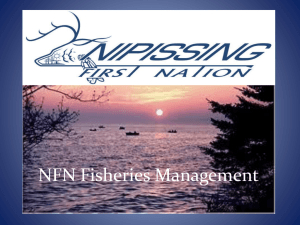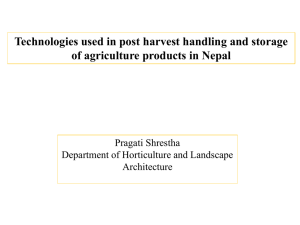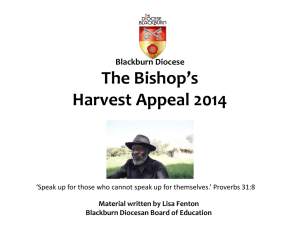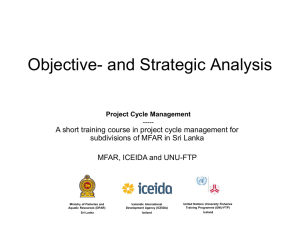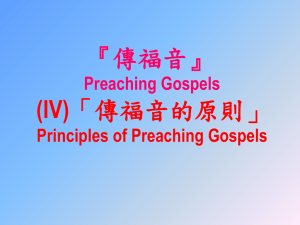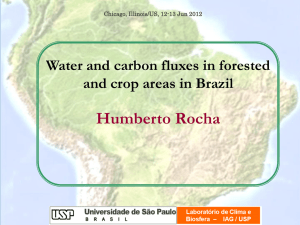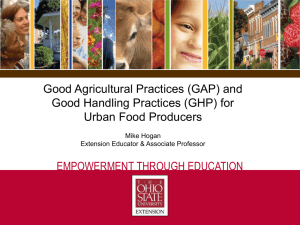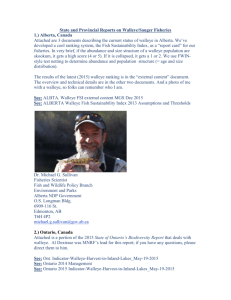Lake Nipissing: Ecology & Fisheries
advertisement
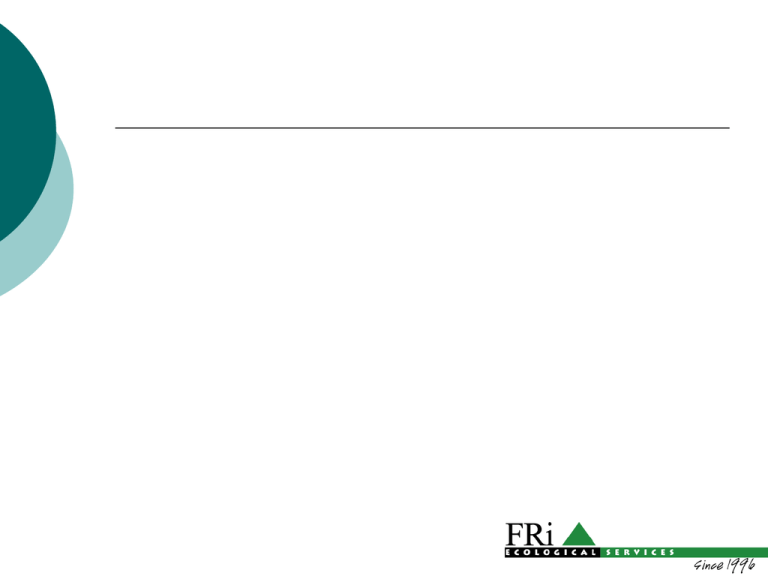
Lake Nipissing: Ecology & Fisheries Richard Rowe, Senior Biologist Lake Nipissing: The Last 100 Years Pre-World War I: Blue phase, shadflies & sturgeon decline World War I: The Beef & Bacon Initiative 1940s & 1950s Tourism, Yellow ‘seeding’, 1st Blue-Green report 1960s & 1970s Tourism explosion, Fisheries assessment, ice fishing, blue ‘phased’ out Lake Nipissing: The Last 100 Years 1980s to mid 1990s Recreational fishing concern, NFN commercial fishery emerging Mid 1990s to early 2000s NFN commercial fishery concern, loss of fisheries assessment Mid 2000s to 2010 Significant Management Efforts, Walleye fishery slowly improving? 2010-present Walleye fishery decline, ecosystem shifts Habitat Changes The creeping crisis Loss of diversity; loss of insurance Species Introductions & Re-colonization Always a risk of upsetting the ecosystem balance Most Recent Changes in Ecosystem Arguably the biggest changes: Yellow Perch Catch per Net (FWIN) 60 50 40 30 20 10 10 20 09 20 08 20 07 20 06 20 05 20 04 20 03 20 02 20 01 20 00 20 99 19 19 98 0 Other Notable Changes: Energy Flow changes in food web from zooplankton to walleye Herring Smelt Walleye observed feeding on smelt; growth changes, movements? Present Day Lake Nipissing Ecosystem: The Walleye Lake-wide, the top predator and greatest top-down influence on ecosystem (this could be changing) “The most significant population stress on Lake Nipissing walleye continues to be human exploitation” Monitoring the Walleye & the Impacts We Have On It Fall Walleye Index Netting (FWIN) Daily Commercial Harvest Reporting Angler Creel Surveys (Other data sets, other species) Walleye “Management” - Considerations Q: How do you manage walleye? A: You Don’t Fish manage themselves – we try to manage our impacts when needed. Best way to manage impacts on walleye: Protect spawning population = protect the future The Reasons are in the biology: A 4-lb female lays 100,000 eggs So? If there are enough adult walleye left and they spawn, they can increase the population quickly (IF conditions are right and IF there are enough) Lake Nipissing is ideal habitat for walleye So? If weather conditions are suitable and there is a enough spawning fish, Lake Nipissing walleye will produce strong year classes The Key to Management – Keep Enough Spawning Fish in the Lake Approach: Adaptive Management Critical Upper Stock Reference Point Limit Reference Point A combination of science and ‘trial and error’ The Science: Maximum Stock Status Sustainable Yield The Trial/Error: Maintain a harvest significantly lower than this, protect spawning fish and see what happens… Harvest Level Cautious Maximum Harvest Level Healthy Angler Harvest Control directed at Spawning Fish Recreational angling fishery protected slot size Angling season opens after spawn NFN Management efforts to protect spawning walleye Mesh size (minimizes kill of larger spawners) Moratorium (guarantee fish left to spawn) Quota (guarantee fish left to spawn) Reporting harvest (keeping track) Signs of Modern Management Working? Since 2004 (when slot started/NFN started): Spawning stock every year for 5 years in a row (numbers and biomass) Signs of Management Working? Biomass comparison 3.0000 2.5000 kg/net 2.0000 1.5000 NFN formal mgmt 1.0000 0.5000 Slot Size 0.0000 1998 1999 2000 2001 2002 2003 2004 2005 2006 2007 2008 Year > 40 cm > 40 cm Index Nets – wt.Biomass walleye Despite all other stresses on ecosystem to this point, management efforts seemed to be working… Harvest seems to be at level that allows slow increase of spawning stock 140000 Harvest (kg) 120000 100000 80000 60000 Estimated Safe Harvest Level (Maximum sustainable) Total of all walleye harvested (sport + commercial) 40000 20000 NFN formal mgmt Slot Size 20 01 20 02 20 03 20 04 20 05 20 06 20 07 20 08 20 09 20 10 0 Something happened in 2009 Number of spawning walleye in index netting Management stayed the same – reported harvest at desired level Suspicion that ecosystem was changing…again One bad year of data or was this a real change? THE Alarming Trend: Spawning Stock 3.0000 2.5000 1.5000 1.0000 0.5000 0.0000 19 98 19 99 20 00 20 01 20 02 20 03 20 04 20 05 20 06 20 07 20 08 20 09 20 10 20 11 kg/nett 2.0000 Year THE Alarming Trend: Spawning Stock 3.0000 2.5000 1.5000 1.0000 0.5000 0.0000 19 98 19 99 20 00 20 01 20 02 20 03 20 04 20 05 20 06 20 07 20 08 20 09 20 10 20 11 kg/nett 2.0000 Year What Happened? Many contributing factors likely played a role: harvest, ecosystem, nature cycles No one specific cause for the latest decline Harvest STILL Drives the Fishery? 3 120000 2.5 100000 2 80000 1.5 60000 1 40000 0.5 20000 Year 10 20 09 20 08 20 07 20 06 20 05 20 04 20 03 20 02 0 20 01 0 Spawning Stock (kg/net) 140000 20 Harvest (kg) Measured Harvest (NFN + angler yr previous) Spawning Stock Biomass (kg/net) Harvest STILL Drives the Fishery? 3 120000 2.5 100000 2 80000 1.5 60000 1 40000 0.5 20000 Year 10 20 09 20 08 20 07 20 06 20 05 20 04 20 03 20 02 0 20 01 0 Spawning Stock (kg/net) 140000 20 Harvest (kg) Measured Harvest (NFN + angler yr previous) Spawning Stock Biomass (kg/net) Harvest STILL Drives the Fishery? 3 120000 2.5 100000 2 80000 1.5 60000 1 40000 0.5 20000 Year 10 20 09 20 08 20 07 20 06 20 05 20 04 20 03 20 02 0 20 01 0 Spawning Stock (kg/net) 140000 20 Harvest (kg) Measured Harvest (NFN + angler yr previous) Spawning Stock Biomass (kg/net) Harvest STILL Drives the Fishery? 3 120000 2.5 100000 2 80000 1.5 60000 1 40000 0.5 20000 Year 10 20 09 20 08 20 07 20 06 20 05 20 04 20 03 20 02 0 20 01 0 Spawning Stock (kg/net) 140000 20 Harvest (kg) Measured Harvest (NFN + angler yr previous) Spawning Stock Biomass (kg/net) Harvest STILL Drives the Fishery? 3 120000 2.5 100000 2 80000 1.5 60000 1 40000 0.5 20000 Year 10 20 09 20 08 20 07 20 06 20 05 20 04 20 03 20 02 0 20 01 0 Spawning Stock (kg/net) 140000 20 Harvest (kg) Measured Harvest (NFN + angler yr previous) Spawning Stock Biomass (kg/net) Harvest STILL Drives the Fishery? 3 120000 2.5 100000 2 80000 1.5 60000 1 40000 0.5 20000 Year 10 20 09 20 08 20 07 20 06 20 05 20 04 20 03 20 02 0 20 01 0 Spawning Stock (kg/net) 140000 20 Harvest (kg) Measured Harvest (NFN + angler yr previous) Spawning Stock Biomass (kg/net) Harvest STILL Drives the Fishery? 3 120000 2.5 100000 2 80000 1.5 60000 1 40000 0.5 20000 Year 10 20 09 20 08 20 07 20 06 20 05 20 04 20 03 20 02 0 20 01 0 Spawning Stock (kg/net) 140000 20 Harvest (kg) Measured Harvest (NFN + angler yr previous) Spawning Stock Biomass (kg/net) IF Harvest Still Drives Fishery: Extra harvest had to occur in 2009 and 2010 Measured Harvest (NFN + angler yr previous) Spawning Stock Biomass (kg/net) 3 X 120000 100000 X 2.5 2 80000 1.5 60000 1 40000 0.5 20000 Year 10 20 09 20 08 20 07 20 06 20 05 20 04 20 03 20 02 0 20 20 01 0 Spawning Stock (kg/net) 140000 Harvest (kg) Can we “find” extra or unexpected harvest in 2009, 2010 to make sense of existing data? Confirmed Sources: Non-compliance NFN moratorium (ballpark #’s based on occurrences) Commercial spearing possibilities (ballpark numbers based on weather) Undetected angler non-compliance with slot size (ballpark numbers based on Alberta model) Dokis FN commercialization (ballpark #’s based on confirmed reports) Extra Harvest Factor: 3 120000 2.5 100000 2 80000 1.5 60000 1 40000 0.5 20000 Year 10 20 09 20 08 20 07 20 06 20 05 20 04 20 03 20 02 0 20 01 0 Spawning Stock (kg/net) 140000 20 Harvest (kg) Measured Harvest (NFN + angler yr previous) Spawning Stock Biomass (kg/net) Extra Harvest Factor: 3 120000 2.5 100000 2 80000 1.5 60000 1 40000 0.5 20000 Year 10 20 09 20 08 20 07 20 06 20 05 20 04 20 03 20 02 0 20 01 0 Spawning Stock (kg/net) 140000 20 Harvest (kg) Measured Harvest + Estimated Extra Spawning Stock Biomass (kg/net) What Happened - Final Thoughts Should we have done more in 1998; 2004? Did we let our collective guard down for compliance during a time when it was needed most? Did we live off the ‘principle’ of the fishery during times of record low interest? Did we get unlucky from a weather and cyclical perspective? Varying degrees of “Yes” to all of these… Where Does This Leave Us Moving Forward? The Ecosystem In a state of flux SWF abundant, Yellow perch dominant, Walleye’s place uncertain Where Does This Leave Us Moving Forward? The Walleye Fishery Seem to be ‘skinnier; maturing a bit later This + the ‘double gauntlet’ is leading to or has led to a serious situation called ‘recruitment overfishing’ Age 0-1 Age 2-3 Age 3-4 Age 5-7 Age 8+ Age 0-1 Age 2-3 Age 3-4 Age 5-7 Age 8+ Recruitment Overfishing ? Age 0-1 Age 2-3 Age 3-4 Age 5-7 Age 8+ Where Does This Leave Us Moving Forward? The Challenge for the Future 11 20 10 20 09 20 08 20 07 20 06 20 05 20 04 20 03 20 02 20 01 20 00 20 19 19 99 9.00 8.00 7.00 6.00 5.00 4.00 3.00 2.00 1.00 0.00 98 total mean catch (#/net) FWIN Catch Walleye < 30 cm Year Record numbers of young captured in FWIN 2 yrs in a row Can we get them through to become prime spawning stock? Where Does This Leave Us Moving Forward? The Challenge for the Future 11 20 10 20 09 20 08 20 07 20 06 20 05 20 04 20 03 20 02 20 01 20 00 20 19 19 99 9.00 8.00 7.00 6.00 5.00 4.00 3.00 2.00 1.00 0.00 98 total mean catch (#/net) FWIN Catch Walleye < 30 cm Year Record numbers of young captured in FWIN 2 yrs in a row Can we get them through to become prime spawning stock? Where Does This Leave Us Moving Forward? The Challenge for the Future How do we assure that enough of these young make it through? Chances for success depends on both major fisheries IF we make it through – how do we get better compliance during those ‘lean years’? The Next 5 Years: Our Biggest Crisis or Our Greatest Opportunity?
